The AMD A8-7650K APU Review, Also New Testing Methodology
by Ian Cutress on May 12, 2015 10:00 AM ESTGaming Benchmarks: High End
Alien: Isolation
If first person survival mixed with horror is your sort of thing, then Alien: Isolation, based off of the Alien franchise, should be an interesting title. Developed by The Creative Assembly and released in October 2014, Alien: Isolation has won numerous awards from Game Of The Year to several top 10s/25s and Best Horror titles, ratcheting up over a million sales by February 2015. Alien: Isolation uses a custom built engine which includes dynamic sound effects and should be fully multi-core enabled.
For low end graphics, we test at 720p with Ultra settings, whereas for mid and high range graphics we bump this up to 1080p, taking the average frame rate as our marker with a scripted version of the built-in benchmark.
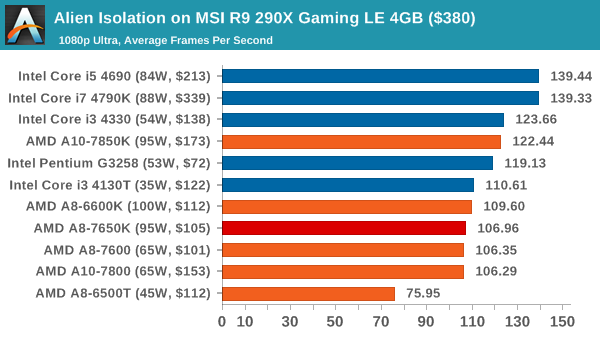
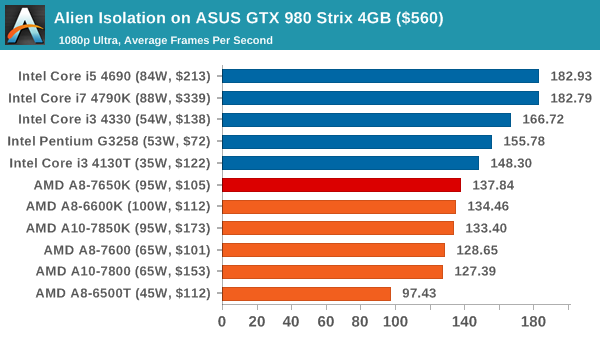
When using the R9 290X, the AMD APUs (except for the 7850K) are within a few percentage points for average frame rates compared to similarly priced Intel processors. You need to spend $200 to get a +30% increase in frame rates. That being said, the frame rates in all our results (except the A8-6500T) were all above 120 FPS on the GTX 980, albeit with the G3258 and i3-4130T ahead by ~10%.
Total War: Attila
The Total War franchise moves on to Attila, another The Creative Assembly development, and is a stand-alone strategy title set in 395AD where the main story line lets the gamer take control of the leader of the Huns in order to conquer parts of the world. Graphically the game can render hundreds/thousands of units on screen at once, all with their individual actions and can put some of the big cards to task.
For low end graphics, we test at 720p with performance settings, recording the average frame rate. With mid and high range graphics, we test at 1080p with the quality setting. In both circumstances, unlimited video memory is enabled and the in-game scripted benchmark is used.
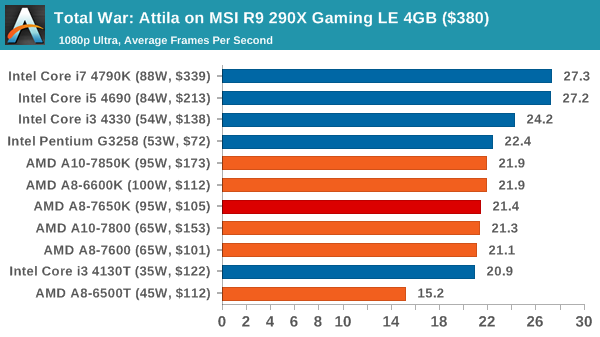
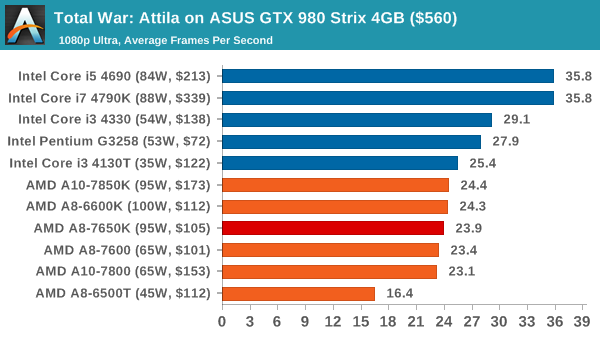
With both of our high end cards, the true quad cores from Intel give performance gains but the better performer here is the G3258 when considering price.
Grand Theft Auto V
The highly anticipated iteration of the Grand Theft Auto franchise finally hit the shelves on April 14th 2015, with both AMD and NVIDIA in tow to help optimize the title. GTA doesn’t provide graphical presets, but opens up the options to users and extends the boundaries by pushing even the hardest systems to the limit using Rockstar’s Advanced Game Engine. Whether the user is flying high in the mountains with long draw distances or dealing with assorted trash in the city, when cranked up to maximum it creates stunning visuals but hard work for both the CPU and the GPU.
For our test we have scripted a version of the in-game benchmark, relying only on the final part which combines a flight scene along with an in-city drive-by followed by a tanker explosion. For low end systems we test at 720p on the lowest settings, whereas mid and high end graphics play at 1080p with very high settings across the board. We record both the average frame rate and the percentage of frames under 60 FPS (16.6ms).
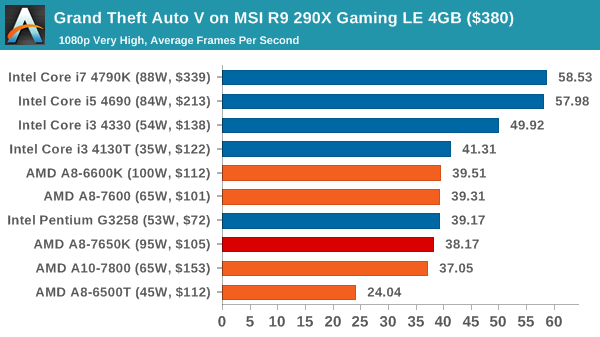
![Grand Theft Auto V on MSI R9 290X Gaming LE 4GB ($380) [Under 60 FPS]](https://images.anandtech.com/graphs/graph9217/74256.png)

![Grand Theft Auto V on ASUS GTX 980 Strix 4GB ($560) [Under 60 FPS]](https://images.anandtech.com/graphs/graph9217/74268.png)
The A8-7650K remains competitive in GTA around the $100 price point, but the i3-4130T for an extra $17 gets a slightly better score.
GRID: Autosport
No graphics tests are complete without some input from Codemasters and the EGO engine, which means for this round of testing we point towards GRID: Autosport, the next iteration in the GRID and racing genre. As with our previous racing testing, each update to the engine aims to add in effects, reflections, detail and realism, with Codemasters making ‘authenticity’ a main focal point for this version.
GRID’s benchmark mode is very flexible, and as a result we created a test race using a shortened version of the Red Bull Ring with twelve cars doing two laps. The car is focus starts last and is quite fast, but usually finishes second or third. For low end graphics we test at 1080p medium settings, whereas mid and high end graphics get the full 1080p maximum. Both the average and minimum frame rates are recorded.
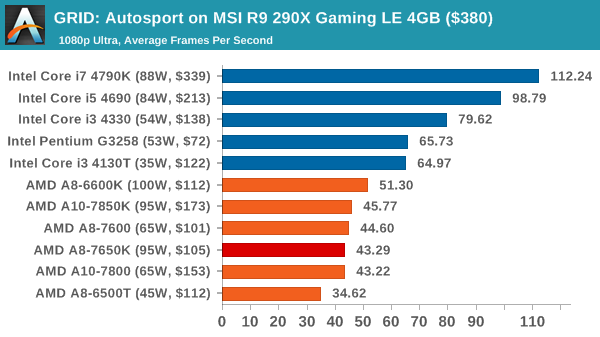
![GRID: Autosport on MSI R9 290X Gaming LE 4GB ($380) [Minimum FPS]](https://images.anandtech.com/graphs/graph9217/74258.png)
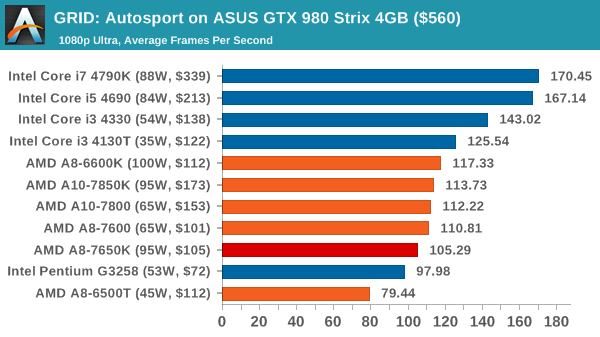
![GRID: Autosport on ASUS GTX 980 Strix 4GB ($560) [Minimum FPS]](https://images.anandtech.com/graphs/graph9217/74270.png)
GRID, as we saw on the other testing, still seems optimised for Intel CPUs. The minimum frame rates are the key metric here, especially on the R9 290X.
Middle-Earth: Shadows of Mordor
The final title in our testing is another battle of system performance with the open world action-adventure title, Shadows of Mordor. Produced by Monolith using the LithTech Jupiter EX engine and numerous detail add-ons, SoM goes for detail and complexity to a large extent, despite having to be cut down from the original plans. The main story itself was written by the same writer as Red Dead Redemption, and SiM received Zero Punctuation’s Game of The Year in 2014.
For testing purposes, SoM gives a dynamic screen resolution setting, allowing us to render at high resolutions that are then scaled down to the monitor. As a result, we get several tests using the in-game benchmark. For low end graphics we examine at 720p with low settings, whereas mid and high end graphics get 1080p Ultra. The top graphics test is also redone at 3840x2160, also with Ultra settings, and we also test two cards at 4K where possible.
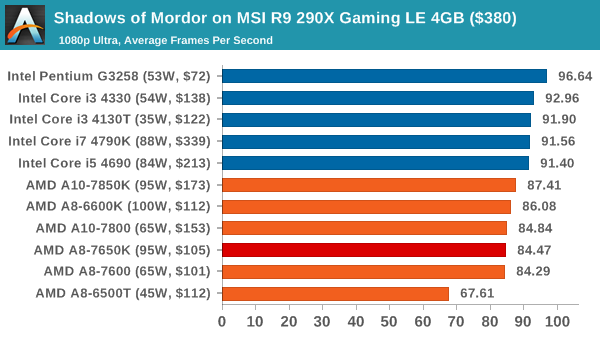
![Shadows of Mordor on MSI R9 290X Gaming LE 4GB ($380) [Minimum FPS]](https://images.anandtech.com/graphs/graph9217/74260.png)

![Shadows of Mordor on ASUS GTX 980 Strix 4GB ($560) [Minimum FPS]](https://images.anandtech.com/graphs/graph9217/74272.png)
SoM at 1080p shows small differences between AMD and Intel here, though you might be hard pressed to notice them.
Middle-Earth: Shadows of Mordor at 4K
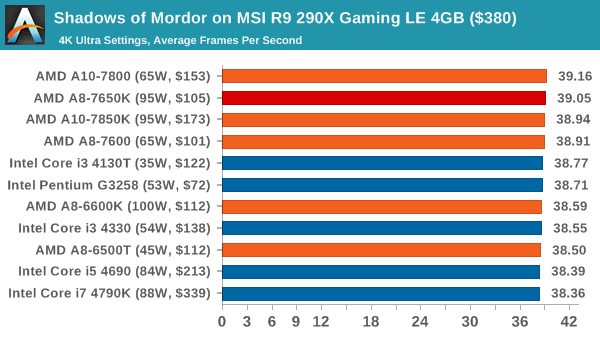
![Shadows of Mordor on MSI R9 290X Gaming LE 4GB ($380) [Minimum FPS]](https://images.anandtech.com/graphs/graph9217/74262.png)
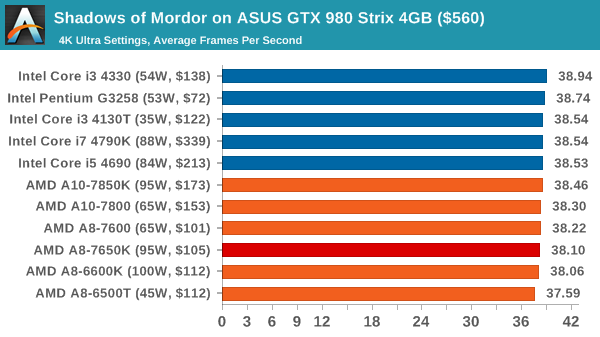
![Shadows of Mordor on ASUS GTX 980 Strix 4GB ($560) [Minimum FPS]](https://images.anandtech.com/graphs/graph9217/74274.png)
Moving to 4K evens out the average frame rates on all our CPUs, although a slight latter is appearing on the minimum frame rates.
Middle-Earth: Shadows of Mordor CrossFire at 4K
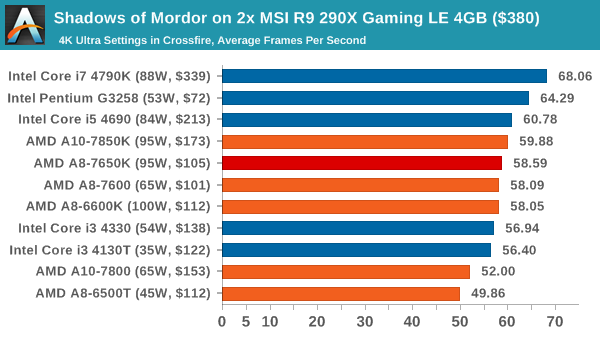
![Shadows of Mordor on 2x MSI R9 290X Gaming LE 4GB ($380) [Minimum FPS]](https://images.anandtech.com/graphs/graph9217/74264.png)
Bumping up to dual R9 290Xs shows that the A8-7650K is highly competitive in both average and minimum frame rates.















177 Comments
View All Comments
V900 - Friday, May 15, 2015 - link
Nah, you can get a really nice gaming PC for even just 500$... Sure it won't be a octo core CPU, probably not even a quad core, but the performance and graphics will be hard to tell apart from a PS4. Especially once DX12 games become common.Yeah, you might get a few more FPS or a few more details in some games on a ps4.
But just set aside the 10-30$ you save every time you buy a game for a PC vs. a PS4 and you should be able to upgrade your computer in a year or less.
V900 - Friday, May 15, 2015 - link
For those on a very tight budget, wish for PC games* AND who already have a motherboard that uses the same socket as these APUs, I would add.Zen is going to require a new socket, so you're kinda stuck in regards to upgrades from this.
And if you have to go out and get a new motherboard as well, than it really only makes sense to go for Intel. Yup,
Skylake is also going to need a new socket, but if you go the Intel route, at least there's a possibility to upgrade to a Haswell i3/i5/i7 from a Pentium down the road, so you have the possibility of a lot more performance.
ES_Revenge - Saturday, May 16, 2015 - link
I don't really get the point of this CPU at all. It comes out, now, in May 2015? And it's really nothing new yet AT bothered to review it? It's a few bucks more than an A8-7600 but it has higher TDP and is otherwise nearly exactly the same. Sure it's unlocked but it doesn't overclock well anyway. Might as well just save the few bucks and the 30W power consumption and get the 7600. OTOH if you want something with better, you'd just go for the $135-140 A10 CPUs w/512 SPs. The 7650K seems to be totally pointless, especially at this point in 2015 where Skylake is around the corner.The Dual Graphics scores look pretty decent (other than GTAV which is clearly not working with it), but there's no mention at all in this review about frametime? I mean have all the frametime issues been solved now (particularly with Dual Graphics which IIRC was the worst for stuttering) that we don't need to even mention it anymore? That's great if that's the case, but the review doesn't even seem to touch on it?
1920.1080p.1280.720p - Sunday, May 17, 2015 - link
For the love of everything, test APUs with casual games. Someone who wants to play something like GTA V is likely going to have a better system. Meanwhile, games like LoL, Dota 2, Sims 4, etc have tons of players who don't have great systems and wouldn't like to spend much on them either. Test games that these products are actually geared towards. I appreciate the inclusion of what the system could become with the addition of differing levels of gpu horsepower, but you are still missing the mark here a bit. Everyone seems to be with APUs and it drives me nuts.johnxxx - Monday, May 18, 2015 - link
hello , what's the best solution for you ?(internet , mail, office , game , listen music and see a movie )
apu + r7 for dual graphics
apu + nvidia card
apu only (oc with a big fan )
x4 860k + r7
x4 860k + nvidia card
or pentium g3xxx + r7
pentium g3xxx + nvidia card
or i3 4150 + r7
i3+nvidia
thank you very much
ES_Revenge - Saturday, May 30, 2015 - link
A little late but it mainly depends on what R7 you're talking about. If you're talking about an R7 240, then yeah it's better to do dual-graphics, 'cause a 240 on its own is not going to do much for gaming. If you're talking about a single R7 260X or 265 then that's a different story (and a much better idea).For gaming, a quad-core CPU really helps for modern games BUT dual-core with HT (like an i3) is quite good too. Dual-core only isn't the greatest of ideas for gaming, TBH. So, ditch the Pentiums and dual-core APUs.
Out of your choices I'd probably go with the i3 4150 and an R7 260X, R7 265/HD 7850, or GTX 750 Ti. Unless you already have some parts (like the motherboard), this will be the best of your choices for gaming (everything else you listed is no problem for any of those CPUs).
The i3 4150 is benefits from newer features in Haswell and has HT. Compared to the X4 860K It may still lose out in some [limited] things which really make use of four physical cores, but not very much and probably not anything you'll be doing anyway. The Haswell i3 also uses very little power so it's good in a small/compact build where you want less heat/noise and can't use a large air cooler easily (or just don't want to spend a lot on a cooler).
If you're talking about an R7 240 though, then go with an A8-7600 and run Dual Graphics. It might be cheaper but it won't be better than the i3 and higher-end R7 card.
CVZalez - Wednesday, May 11, 2016 - link
It's time for this so called benchmarks make the scripts and data processed available to the public, for example, is the AgiSoft PhotoScan OpenCL activated in the preferences, if it's not, only the CPU will be used, and it makes an huge difference, we all know what AMD is good at with those APUs, not in the CPU but in the GPU and multithread, I find it hard to believe that Intel i3 had such better results.